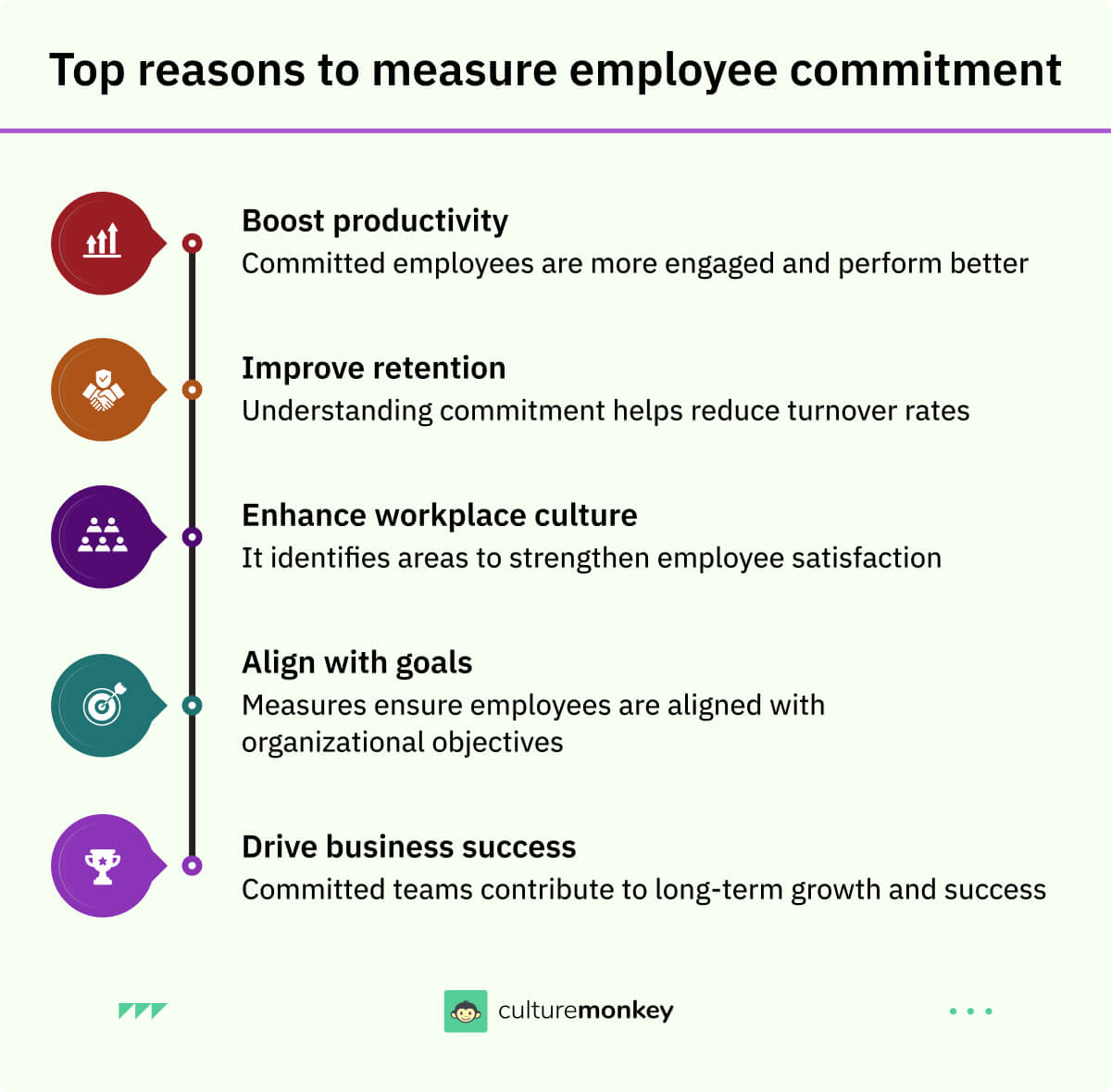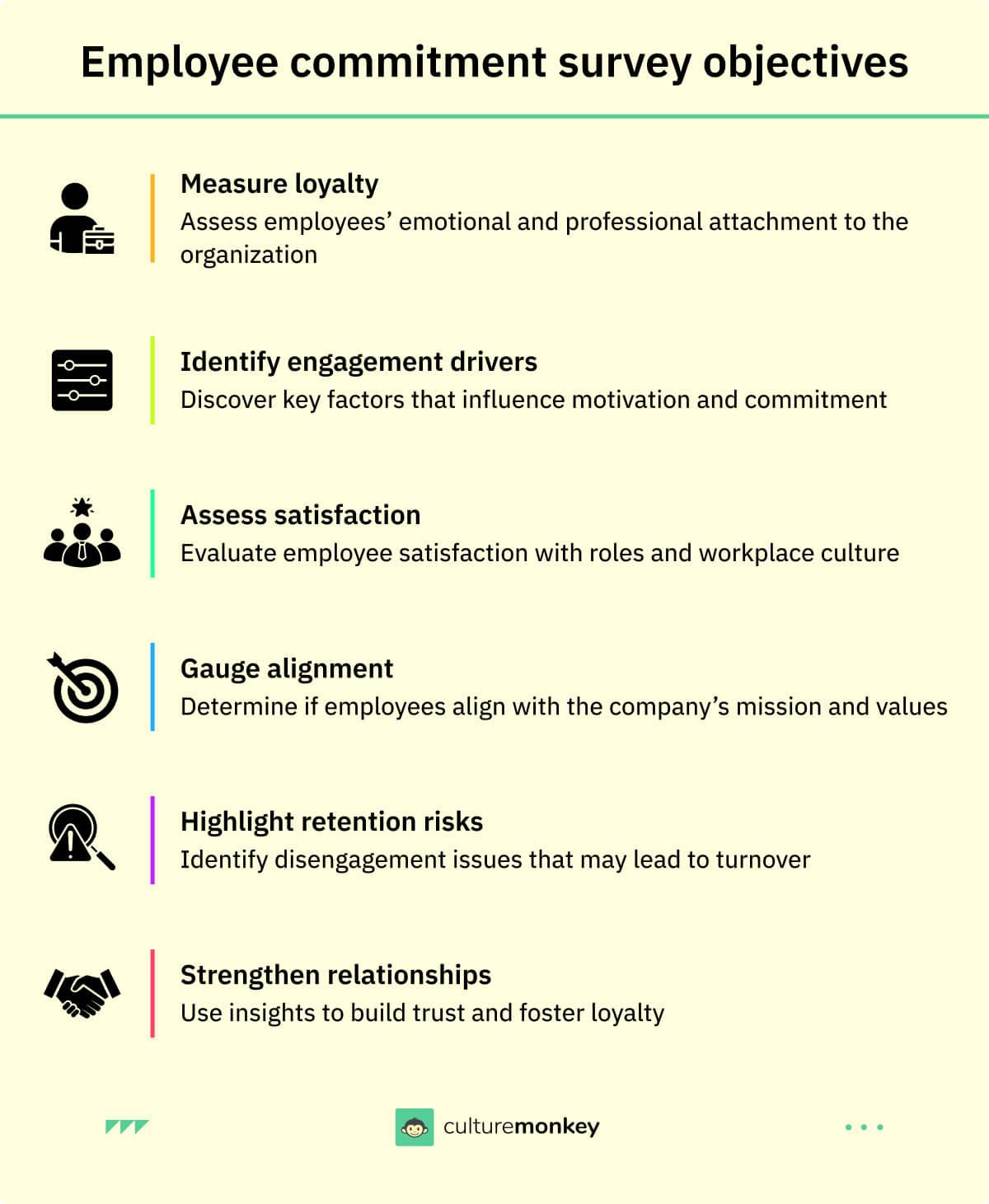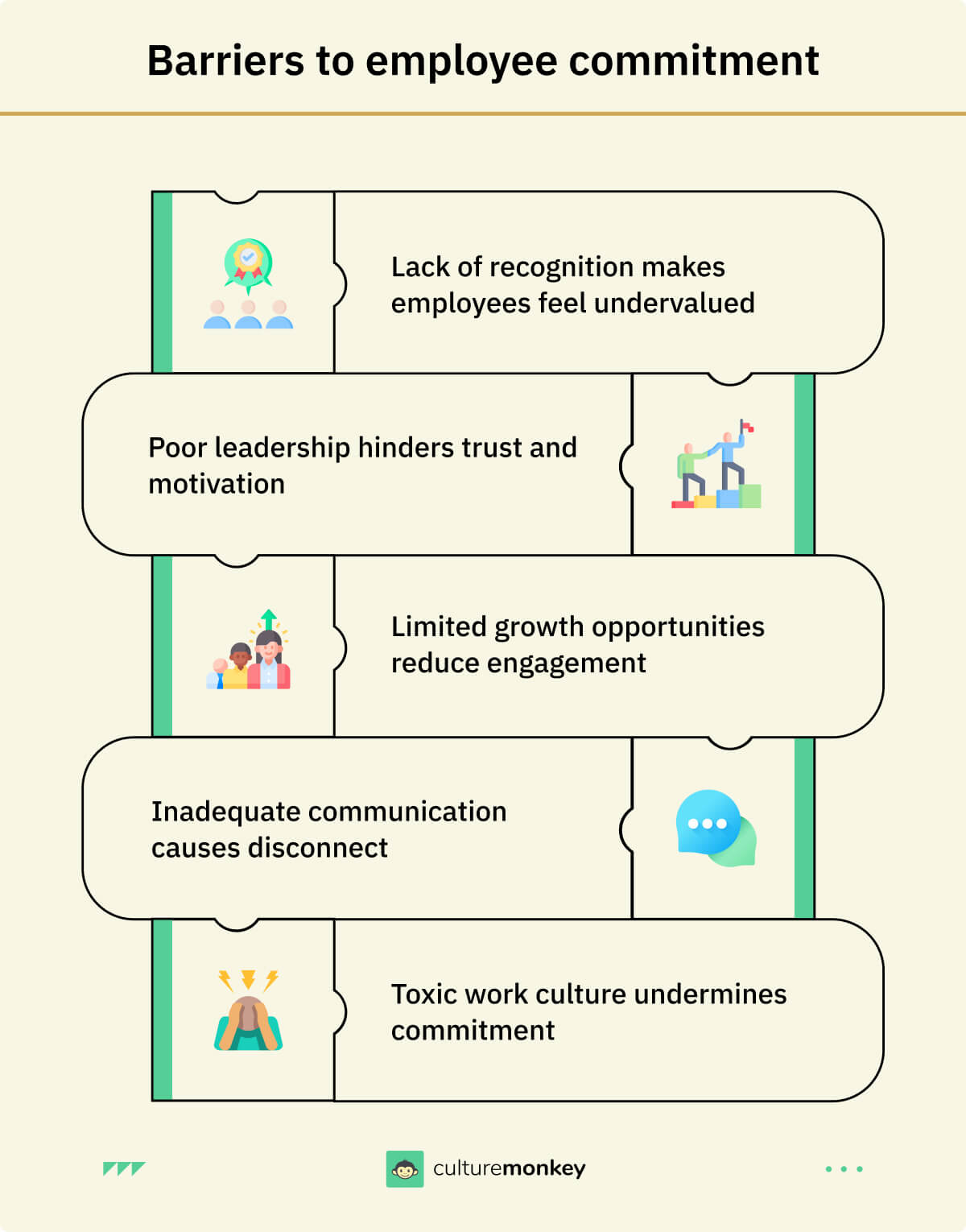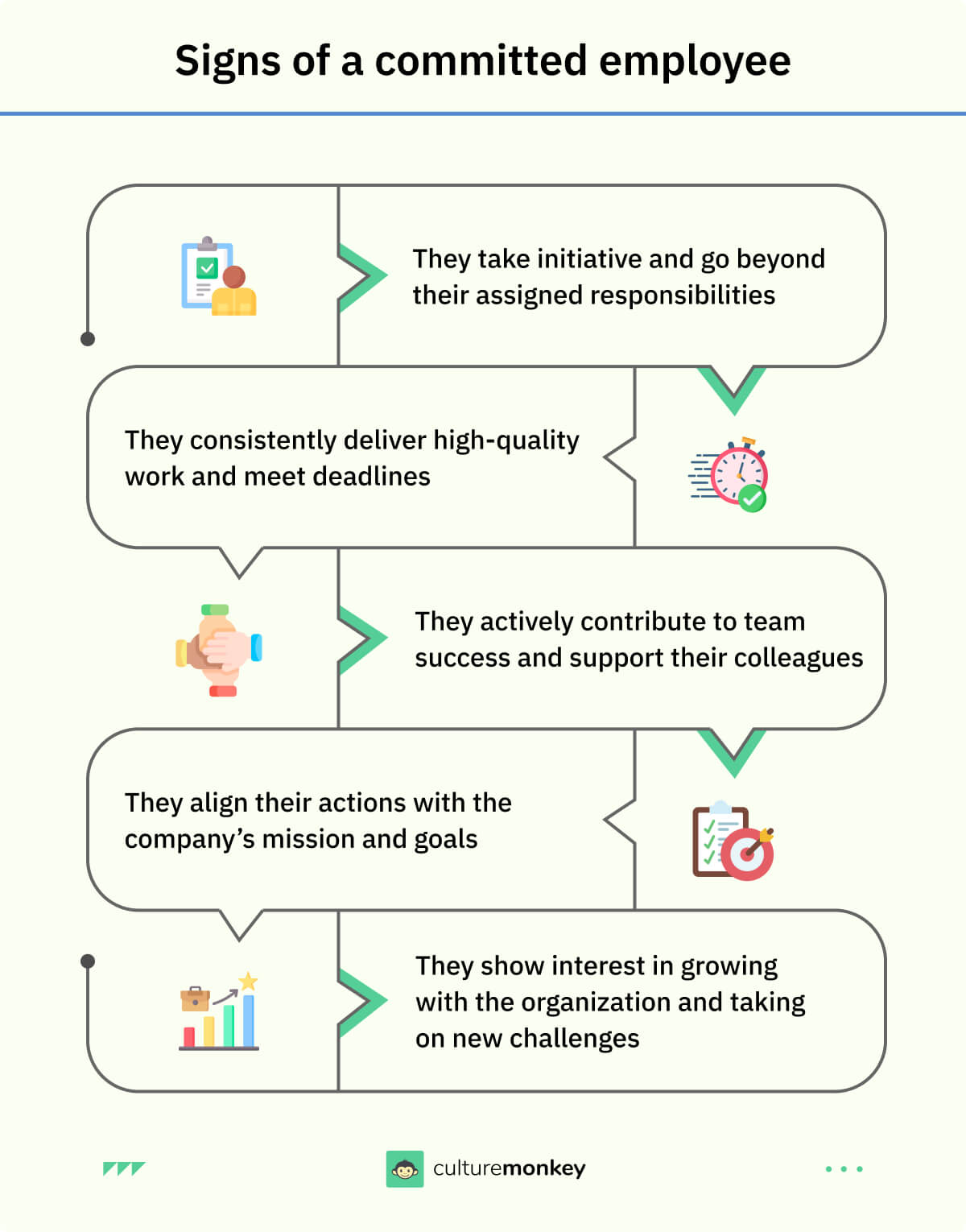What is employee commitment survey: Benefits and top survey questions to gauge productivity

Imagine this: Your company just rolled out an ambitious new project, but the energy in the office feels off. Deadlines are being missed, employee engagement is dipping, and turnover is creeping up.
You notice Sarah from marketing—usually your most enthusiastic team member—sitting quietly in meetings, barely contributing. John from sales, who once hit every target, now seems disengaged. You could guess at the problem or assume the workload is to blame—but what if there’s more to it?
This is where an employee commitment survey comes in. By asking targeted questions, you can uncover the root causes of disengagement—whether it’s burnout, lack of recognition, or unclear career paths. With actionable insights, you can rebuild trust, reignite passion, and create a workplace where employees feel truly valued and motivated.
Blog Highlights


What is employee commitment at work?

Employee commitment at work is the unwavering dedication and emotional attachment employees have towards their jobs and their organization. It goes beyond mere job satisfaction, as committed employees are deeply invested in the company's success, values, and goals. They willingly go the extra mile, show loyalty, and stay motivated even in challenging times.
Committed employees are more likely to stay with their employer for the long term, resulting in reduced turnover rates. This commitment is often reflected in their enthusiasm, proactive problem-solving, and genuine desire to contribute to the organization's growth. It is the secret sauce that fosters a thriving and productive workplace where employees feel valued and connected to the bigger picture.



On what high-performing companies should be striving to create: A great place for great people to do great work.
Former CEO
Carlson Companies
What are the three types of employee commitment?

Understanding these three types of employees commitment helps organizations tailor their engagement strategies and retention efforts to meet the diverse needs of different groups in their workforce. Combining these commitment types can provide a holistic view of employees' dedication to their jobs and the organization. Let’s take a look at them.
- Affective commitment: This type of commitment is rooted in employees' emotional attachment to their organization. Employees with high affective commitment genuinely enjoy their work, believe in the company's mission, and feel a strong sense of belonging. They will likely stay with the organization because they want to, driven by their positive feelings and loyalty.
- Continuance commitment: Continuance commitment is based on employees' perception of the costs of leaving the organization. It's not so much about a deep emotional connection as it is about practical considerations. Employees with high continuance commitment stay because they believe the benefits of staying outweigh the potential costs of joining a different organization, such as finding a new job or losing certain benefits.
- Normative commitment: Normative commitment is a sense of obligation to stay with the organization. Employees with this type of commitment feel they should remain with the company because it's the "right" thing to do. This commitment may be influenced by a sense of duty, moral values, or the belief that the organization has invested in its development, creating a sense of obligation to reciprocate.
How do you measure employee commitment?

To measure organizational commitment, it is essential to understand the level of dedication and engagement within your organization. Several methods and tools can help gauge employee commitment:
- Employee surveys: Conducting regular surveys, such as employee engagement surveys or employee satisfaction surveys, can provide insights into employee commitment. These surveys typically include questions about job satisfaction, loyalty, motivation, and overall commitment to the organization.
- Exit interviews: When employees leave the organization, conducting exit interviews can shed light on their reasons for departure. This can help management identify issues related to commitment, such as dissatisfaction or lack of engagement.

- Employee net promoter score (eNPS): Similar to the Net Promoter Score used in customer feedback, eNPS asks employees how likely they are to recommend the organization as a place to work. High eNPS scores indicate a strong level of organizational commitment to and engagement.
- Performance metrics: Analyzing employee performance metrics, such as productivity, attendance, and quality of work, can indirectly measure commitment. Committed employees often perform better and are more reliable.
- Retention rates: High retention rates suggest that employees are committed to the growth opportunities in the organization. Low turnover is a sign that employees are satisfied and engaged.
- Benchmarking: Comparing your organization's commitment metrics to industry benchmarks or competitors can help identify areas where improvement is needed.
- Training and development participation: Actively involved employees in training and development programs showcase a commitment to personal and professional growth. Monitoring participation rates and engagement in these initiatives provides insights into the workforce's dedication to continuously improve employee commitment.
- Cross-functional collaboration: Assessing employees' willingness to collaborate across departments and teams indicates a broader commitment to organizational success. A cohesive, collaborative environment is often indicative of high employee commitment.
- Innovation and idea contribution: Employees who contribute innovative ideas and suggestions demonstrate a vested interest in the company's progress. Tracking the frequency and quality of these contributions unveils a unique facet of commitment to the organization's success.
- Employee recognition programs: Participation and engagement in employee recognition programs can be a barometer of commitment. Actively involved employees, either as recipients or contributors, signal a positive commitment to the company's values and culture.
What is an employee commitment survey?
An employee commitment survey is a structured questionnaire or assessment tool designed to measure the level of commitment, engagement, and loyalty of various groups of employees within an organization.
It is a critical component of employee feedback and organizational development efforts. It plays a crucial role in understanding employee sentiments, identifying areas for improvement, and fostering a workplace culture that encourages loyalty and dedication.
Employee commitment surveys are often conducted periodically, such as annually or semi-annually, to track changes over time and evaluate the impact of organizational initiatives. And to ensure that the feedback is honest, they are often anonymous.
How to conduct an employee commitment survey?

Conducting an employee commitment survey is crucial for understanding workforce loyalty and identifying areas for improvement. Follow these six steps for effective execution:
- Set clear objectives: Define the purpose of the survey, such as measuring commitment levels, evaluating engagement strategies, or identifying areas for improvement.
- Design effective questions: Include a mix of quantitative metrics (e.g., rating scales) and qualitative open-ended questions to capture detailed insights.
- Ensure anonymity: Guarantee confidentiality to encourage honest and candid responses, improving the reliability of the data collected.
- Communicate the purpose: Clearly explain to employees why the survey is being conducted and how their feedback will drive organizational improvements.
- Analyze and share results: Use statistical tools to interpret data, share key findings with employees, and highlight areas that require attention while maintaining transparency.
- Act on feedback: Develop actionable plans based on survey insights, implement strategies to address concerns, and regularly follow up to monitor progress and show commitment to change.
Employee commitment survey objectives

Employee commitment surveys are designed to achieve several key objectives, all of which contribute to improving workplace engagement, satisfaction, and overall organizational performance. Here are the primary objectives of conducting such surveys:
- Assessing commitment: Employee commitment surveys aim to gauge employees' emotional and psychological attachment to their jobs and the organization. This includes their willingness to go the extra mile, stay with the company, and actively contribute to its success.
- Identifying issues: These surveys help managers identify areas where employees may be disengaged or dissatisfied, allowing organizations to address these issues proactively.
- Improving employee retention: By understanding the factors that influence commitment, organizations can take steps to improve retention rates and reduce employee turnover.
- Identify drivers of commitment: Pinpoint the factors and aspects of the work environment that positively or negatively impact employee commitment. This includes understanding what motivates and retains employees.
- Measure job satisfaction: Assess overall job satisfaction and identify specific areas where employees are content or dissatisfied with job performance. This research can help HR and leadership teams address issues and make improvements.
- Detect early warning signs: Identify early signs of disengagement or declining commitment among employees, allowing organizations to take preventive action before issues escalate.
Employee commitment survey benefits

Employee commitment surveys offer numerous benefits to organizations, helping them enhance their workplace culture and drive overall performance. Here are the top five benefits of conducting these surveys:
- Insightful data for informed decision-making: Employee commitment surveys provide valuable data and feedback that enable organizations to make informed decisions. By understanding employee sentiments, organizations can identify areas for improvement, prioritize initiatives, and allocate resources effectively to address key issues.
- Improved employee engagement: These surveys foster a sense of involvement and empowerment among employees involved. When employees see that their opinions are valued and acted upon, they are more likely to become engaged and committed to their work and the organization. This increased engagement can lead to higher productivity and job satisfaction.
- Enhanced workplace culture: Employee commitment surveys help organizations identify aspects of their workplace culture that require attention. Organizations can create a positive and inclusive culture that promotes commitment and loyalty by addressing issues related to communication, leadership, work-life balance, and more.
- Talent retention: High levels of employee commitment are often a key factor associated with lower turnover rates. By identifying the drivers of commitment and implementing strategies to enhance it, organizations can retain their top talent, reduce recruitment and training costs, and maintain a stable, experienced workforce.
- Competitive advantage: Organizations that prioritize employee commitment and act on survey research and findings often gain a competitive advantage in the labor market. A workplace known for its commitment to employee well-being and development is more likely to attract top talent and retain valuable employees, ultimately contributing to long-term business success.
Common mistakes to avoid in employee commitment survey

Conducting employee commitment surveys is essential for understanding workforce loyalty and engagement. However, several common mistakes can undermine their effectiveness:
- Lack of clear objectives: Without specific goals, surveys can become unfocused, leading to irrelevant data that doesn't inform actionable strategies.
- Poor survey design: Ambiguous or leading questions can confuse respondents, resulting in unreliable data. It's crucial to craft clear, unbiased questions to gather accurate insights.

- Ignoring anonymity: Failing to ensure respondent confidentiality can deter honest feedback, skewing results. Guaranteeing anonymity encourages openness and candor.
- Infrequent surveys: Conducting surveys too sporadically can miss shifts in employee sentiment. Regular surveys help track trends and address issues promptly.
- Neglecting to act on feedback: Collecting responses without implementing changes can lead to employee disengagement. Demonstrating a commitment to addressing concerns is vital for maintaining trust.
- Overlooking demographic differences: Ignoring the diverse backgrounds and experiences of employees can result in a one-size-fits-all approach that fails to address specific group needs. Tailoring surveys to capture diverse perspectives ensures inclusivity.
- Survey fatigue: Overloading employees with too many surveys can lead to decreased participation and disengagement. Balancing frequency and relevance is key to maintaining engagement.
- Failure to communicate purpose: Not clearly explaining the survey's intent can result in skepticism and low participation. Transparent communication about objectives and potential impacts encourages involvement.
How to increase employee commitment?

Enhancing employee commitment is vital for organizational success, as it leads to increased productivity, reduced turnover, and a more cohesive work environment. To achieve this, consider implementing the following strategies:
- Foster open communication: Encourage transparent dialogue between management and staff to build trust and ensure employees feel heard and valued.
- Provide growth opportunities: Offer continuous learning and career advancement prospects to motivate employees and demonstrate investment in their professional development.
- Recognize and reward contributions: Implement recognition programs that acknowledge individual and team achievements, reinforcing positive behavior and commitment.
- Promote work-life balance: Support flexible working arrangements and emphasize the importance of personal well-being to prevent burnout and maintain morale.
- Align roles with company vision: Ensure employees understand how their responsibilities contribute to organizational goals, fostering a sense of purpose and belonging.
Employee engagement vs commitment

| Aspect | Employee engagement | Employee commitment |
|---|---|---|
| Definition | Emotional and psychological investment in daily tasks and responsibilities. | Loyalty and attachment to the organization, influencing long-term retention. |
| Focus | Centers on enthusiasm and connection with specific work tasks. | Emphasizes the overall relationship between the employee and the organization. |
| Nature | Short-term and can fluctuate based on immediate work experiences. | Long-term and tends to remain stable over time. |
| Motivational drivers | Driven by interest, passion, and enjoyment in work. | Motivated by trust, alignment with values, and a sense of belonging. |
| Outcome | Results in higher productivity and improved daily performance. | Reduces turnover and builds a stable, committed workforce. |
Employee engagement statistics that you should know
- According to Gallup's State of the Global Workplace 2023 report, 23% of employees are engaged at work, marking the highest figure since measurement began in 2009.
- In a study examining the impact of remote work, Forbes reveals that frequent virtual meetings take a toll on employees. 38% of remote workers reported feeling exhausted after daily virtual meetings, while 30% experienced heightened stress.
- Citing Trade Press Services, effective internal communications have the power to motivate 85% of employees, fostering higher levels of engagement within the workplace.
- Findings from a Korn Ferry survey indicate that 33% of employees leave their current roles due to workplace boredom, seeking new challenges in their professional journey.
- Gallup's meta-analysis underscores the financial impact of employee engagement. Business units scoring highest in employee engagement demonstrated a remarkable 21% increase in profitability compared to units in the lowest quartile, as reported by Gallup.
What are the indicators of commitment at work?

Here are 15 distinct indicators of commitment at work that organizations can use to assess the dedication and engagement of their employees:
- Initiative and proactivity: Committed employees take the initiative to improve processes, suggest innovations, and actively seek solutions to challenges. They go beyond their job descriptions to contribute positively to the organization.
- Consistent attendance and punctuality: Employees who are committed to their roles and the organization tend to have excellent attendance records and are punctual, demonstrating their reliability and dedication.
- Strong team collaboration: Committed individuals work effectively within teams, fostering a collaborative and supportive environment. They willingly share knowledge, mentor others, and contribute to the collective success of the group.
- High-quality work: Committed employees consistently produce high-quality work, paying attention to detail and striving for excellence in their tasks. Their work reflects their dedication to achieving the best possible outcomes.
- Longevity with the company: An extended tenure with the organization is a strong indicator of commitment. Employees who have been with the company for a significant period often demonstrate loyalty and satisfaction with their roles.
- Positive attitude: Committed employees maintain a positive attitude, even in challenging situations. They approach their work with enthusiasm, resilience, and a solution-oriented mindset.
- Advocacy and referrals: Committed employees are likely to speak positively about their organization to friends, family, and professional networks. They may also refer potential talent to the company, acting as brand ambassadors.
- Alignment with company values: Commitment often stems from a shared belief in the organization's values and mission. Employees who align with these principles are more likely to commit to their roles and the company's goals.
- Professional development: Committed individuals are invested in their own growth and development, actively seeking opportunities for learning and skill enhancement. They see their career progression as intertwined with the organization's success.
- Volunteering for additional responsibilities: Employees who willingly take on extra responsibilities, whether in projects, leadership roles, or cross-functional teams, demonstrate a commitment to contributing beyond their core duties.
- Adaptability and flexibility: Committed employee exhibits a willingness to adapt to changes and demonstrate flexibility in their roles. They view challenges as opportunities for growth and can seamlessly adjust to evolving work environments.
- Conflict resolution skills: Individuals dedicated to their roles often possess strong conflict resolution skills, contributing to a harmonious work environment. Their ability to navigate disagreements constructively showcases a commitment to maintaining positive workplace relationships.
- Continuous feedback seekers: Committed employees actively seek feedback on their performance, showcasing a desire for improvement and growth. Their openness to constructive criticism reflects a commitment to personal and professional development.
- Cross-departmental engagement: Engaging with colleagues beyond one's immediate team indicates a broader commitment to the organization. Committed employees network across departments, fostering a sense of unity and collaboration throughout the entire organization.
- Innovative problem solving: Committed individuals not only identify challenges but actively engage in innovative problem-solving. Their proactive approach to overcoming obstacles demonstrates a commitment to driving positive change within the organization.

Why should you implement employee commitment questionnaire?

The implementation of an employee commitment questionnaire isn't merely a choice; it's a strategic imperative in the pursuit of organizational excellence. Here are ten compelling reasons why your company should consider implementing this invaluable tool:
- Diagnostic precision: Pinpoint areas to increase employee commitment with precision, gaining insights into the factors that influence job commitment.
- Engagement calibration: Fine-tune your engagement strategies based on real-time feedback, fostering a workplace culture that resonates with your team.
- Performance enhancement: Identify and address issues hindering productivity, laying the groundwork for a more efficient and effective workforce.
- Retention insights: Uncover the underlying factors influencing employee retention, enabling proactive measures to retain top talent.
- Cultural alignment: Ensure that your organizational culture aligns with employee values, fostering a sense of belonging and loyalty.
- Strategic decision support: Leverage data-driven decision-making, empowering leadership with actionable insights for strategic planning.
- Communication optimization: Enhance internal communication channels based on employee feedback, promoting transparency and trust within the organization.
- Wellness monitoring: Track employee well-being indicators, proactively addressing burnout and workplace stress to create a healthier workplace environment.
- Talent development: Identify skill gaps and training needs, enabling targeted talent development programs that elevate individual and team capabilities.
- Competitive edge: Gain a competitive advantage by fostering a committed and motivated workforce, setting your company apart in the market.
51 Employee commitment survey questions you should ask at work

Here are 51 unique employee commitment survey questions that organizations can use to assess various aspects of employee dedication, effort, and engagement:
Click to copy survey questions content_copy
Overall commitment
- On a scale of 1 to 10, how committed do you feel to our organization?
- How likely are you to recommend our organization as a great place to work?
- Do you feel a strong emotional connection to our company's mission and values?
- How often do you think about leaving our organization for another job?
Job satisfaction
- Are you satisfied with your current role and responsibilities?
- Do you feel that your skills and talents are being fully utilized in your current position?
- Are you content with the work-life balance in your role?
- How well does your job align with your career aspirations?
Workplace relationships
- Do you feel supported by your immediate supervisor/manager in your daily work?
- Do you have strong working relationships with your colleagues and team members?
- Are you satisfied with the level of communication within your team and with other departments?
- Do you feel that your opinions and ideas are valued by your colleagues and supervisors?
Company culture
- Does our company's culture align with your personal values and beliefs?
- Are you proud to be associated with our organization?
- Do you feel a sense of belonging and inclusion within our workplace?
- Do you believe that our company fosters a culture of innovation and continuous improvement?
Development opportunities
- Are you satisfied with the training and development opportunities provided by our organization?
- Do you feel that your professional growth is actively supported by the company?
- Are you given opportunities to work on challenging projects and expand your skills?
- Do you believe that your professional development is a priority for our organization?
Feedback and recognition
- How often do you receive feedback on your performance from your supervisor?
- Do you feel that your contributions are recognized and appreciated by your peers and supervisors?
- Are performance evaluations and goal-setting discussions conducted regularly and effectively?
- Does our organization have a fair and transparent performance review process?
Employee well-being
- Does our organization prioritize employee well-being and work-life balance?
- Are you satisfied with the benefits and perks offered by our company?
- Do you feel that our organization actively supports your physical and mental health?
- Are you comfortable taking advantage of the support services provided by our organization?
Organizational vision and goals
- Do you have a clear understanding of our organization's long-term vision and goals?
- Do you feel that your work contributes to the achievement of our company's mission?
- Are you aware of the strategic initiatives and direction of our organization?
- Do you believe that our organization is well-positioned for future success?
Open-ended question
- Is there anything else you would like to share regarding your commitment to our organization or any suggestions for improvement?
Employee recognition programs
- How engaged are you in our employee recognition programs?
- Do you believe our recognition programs adequately acknowledge your efforts?
- Have you ever received peer-to-peer recognition that left a lasting impact on you?
Communication channels
- How effective do you find our communication channels for disseminating important company information?
- Do you feel well-informed about organizational changes and updates?
- Are there specific communication channels or methods you believe could be improved?
Professional development opportunities
- To what extent do you feel our organization provides opportunities for continuous learning?
- Have you participated in any external training or conferences facilitated by the company?
- How satisfied are you with the mentorship programs offered for professional development?
Team recognition
- How often does your team celebrate collective achievements or milestones?
- Do you feel your team's accomplishments are adequately recognized by leadership?
- In your opinion, how can team achievements be better acknowledged within the organization?
Inclusivity and diversity
- How inclusive do you perceive our workplace in terms of diversity?
- Have you witnessed or experienced initiatives that promote diversity and inclusion?
- In what ways do you think the organization can further enhance its commitment to diversity and inclusivity?
Employee wellness programs
- Have you participated in any employee wellness programs provided by the organization?
- How effective do you believe these wellness programs are in supporting your overall well-being?
- Are there specific wellness initiatives you would like to see implemented in the future?
What is employee commitment survey data?

Employee commitment survey data offers organizations valuable insights into their workforce's engagement, loyalty, and alignment with company goals. These surveys assess job satisfaction, perceptions of leadership, and alignment with the organization’s mission, providing a detailed view of the employee experience.
The data includes quantitative metrics like engagement scores, satisfaction ratings, and likelihood-to-stay indicators, which guide decision-making through statistical analysis and trend identification. Open-ended questions add qualitative depth, offering narrative context to enrich numerical findings.
This data isn’t static but evolves over time, reflecting organizational dynamics. Regular survey cycles help track trends, evaluate interventions, and adapt strategies to foster a positive work environment. Skilled analysts can interpret patterns, identify red flags, and highlight areas of strength, turning raw data into actionable insights.
The ultimate goal is to strategically apply these findings to create a workplace that resonates with employees and drives organizational success.
How can an employee survey tool measure employee commitment?
An employee survey tool is critical for organizations aiming to measure and understand employee commitment comprehensively. These tools serve as a structured and standardized form and means of collecting descriptive and inferential statistics, offering invaluable insights into various facets of organizational commitment.
One of the primary advantages of these survey tools is their ability to provide a systematic and consistent data collection process. Organizations can construct surveys with tailored questions designed to assess commitment factors such as job satisfaction, loyalty, and engagement.
This method ensures that all employees are exposed to the same inquiries, providing a coherent dataset that can be analyzed and compared effectively.
Moreover, many employee survey tools offer the option of anonymous responses, fostering an environment of transparency. Employees can express their thoughts and concerns openly without fear of potential repercussions. This anonymity encourages more candid and honest feedback, resulting in survey data that genuinely reflects employee perceptions and sentiments.
They also provide quantitative data, often assigning numerical values to responses. This approach allows for an objective analysis of commitment levels, facilitating trend identification and pinpointing areas requiring attention or improvement.
Conclusion
Employee commitment surveys are a game-changer for building a dedicated, engaged, and loyal workforce. By understanding employee motivations, addressing their concerns, and aligning organizational efforts, companies can create a culture where employees feel valued and committed to their roles.
This is where CultureMonkey makes a difference. With its customizable employee engagement platform, real-time analytics, and actionable insights, it enables organizations to measure and enhance employee commitment effectively.
Take the first step towards fostering a committed workforce by implementing employee commitment surveys with CultureMonkey.
Summary
The employee commitment survey is a powerful tool for understanding workforce loyalty and engagement. It highlights how organizations can use these surveys to identify factors driving employee motivation, uncover retention risks, and align employee goals with company objectives.
By leveraging the insights from commitment surveys, businesses can enhance employee satisfaction, build trust, and foster a culture of dedication and growth, ultimately driving organizational success.
FAQs
1) How often should we measure organizational commitment?
Conducting employee surveys to measure commitment annually is a recommended practice. This frequency allows organizations to maintain a regular pulse on employee commitment levels, track changes, and adapt strategies accordingly. It strikes a balance between staying informed and preventing survey fatigue.
2) How can we ensure survey responses remain anonymous?
Ensuring anonymity is crucial for honest feedback. To achieve this, use a trusted survey tool that offers anonymous response options. Additionally, clearly communicate to employees that their responses will be treated confidentially, assuring them of their privacy.
3) What should we do with the survey results?
Once you've collected survey data, the next step is to analyze it thoroughly. Identify areas where improvement is needed, develop action plans based on these findings, and prioritize initiatives. Equally important is transparently communicating the survey results and the subsequent action steps to employees to demonstrate responsiveness.
4) Can we benchmark our results against industry standards?
Yes, benchmarking your survey results against industry standards is a valuable practice. It provides context and helps you understand how your organization compares to industry norms. This comparison enables you to set realistic goals for improvement and align your strategies with best practices.
5) How can we encourage more participation in the survey?
Boosting participation is essential for survey effectiveness. Promote the survey's importance within the organization, emphasizing how employee feedback drives positive change. Additionally, reassure employees about the confidentiality of their responses. Consider offering incentives, such as small rewards or public recognition, to motivate higher participation rates and engagement in the survey process.




